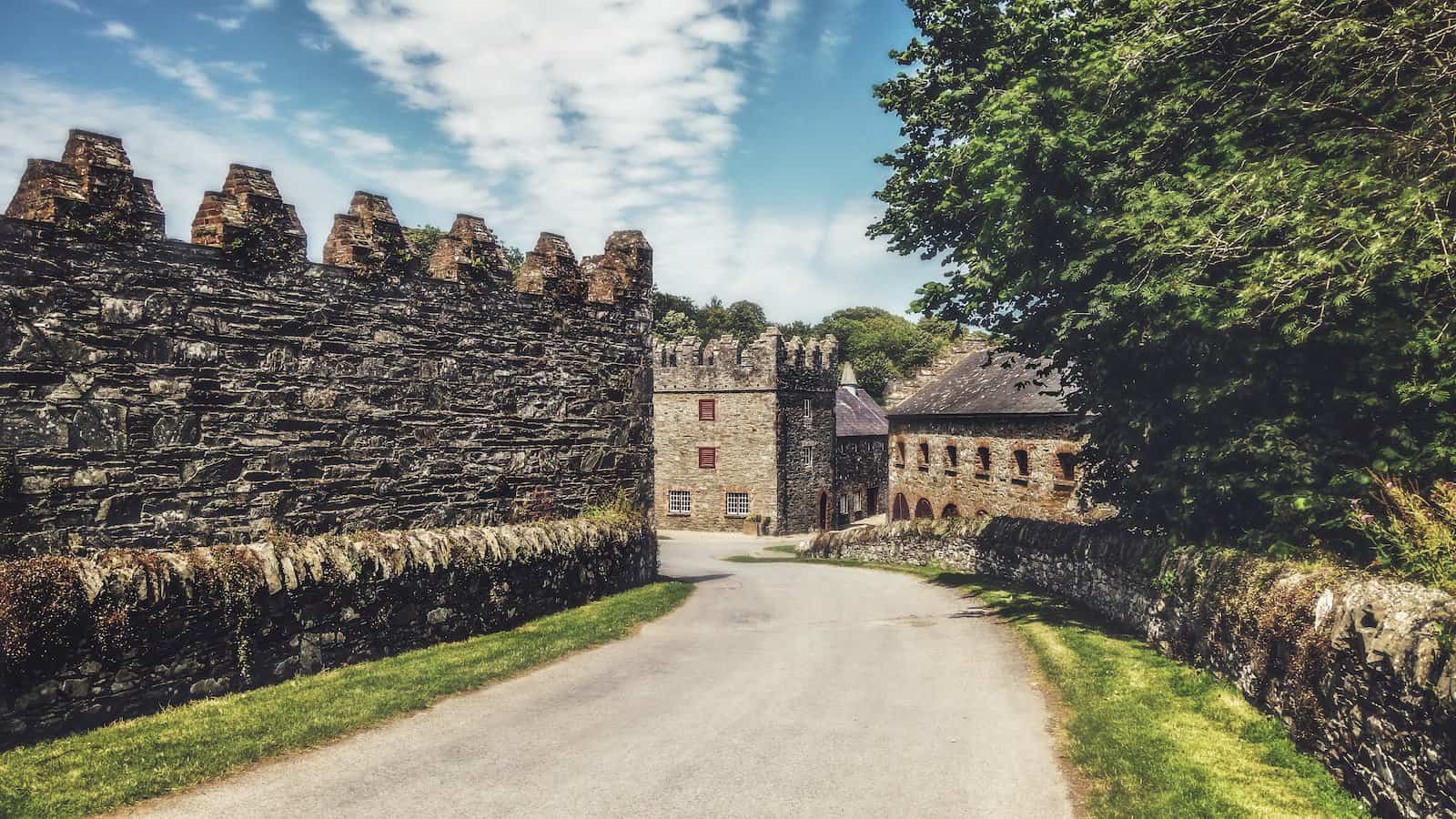This is the last set of constituencies in this series. It coincides with the publication of the Final Report of the NI Boundary Commission. As expected there has only been minor change since the Commissions previous proposals.
- Some 1,000 electors in Abbey ward who were previously being allocated to East Antrim will now be placed in North Belfast. With Westminster turnouts below 70% this represents at best 700 voters.
- Upper Bann gains some 2,600 electors from Gransha ward who were previously allocated to South Down, and 200 from Donaghloney who had been placed in Lagan Valley.
- 30 electors are moved from South Down to Strangford.
None of these changes has the capacity to change the conclusions of the analyses made for the constituencies already covered.
In the normal course of events Parliament will have a vote on the proposals for the whole of the UK this autumn. The new boundaries will become effective for any subsequent Westminster or Assembly election.
For a full explanation of the various charts used in this piece please see the introduction in the first article in this series.
Strangford
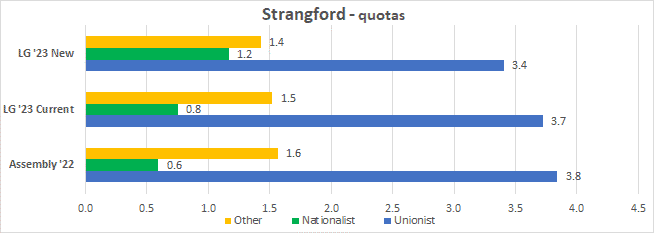
Even though the council election showed a small swing to nationalists (up 1% on the previous council elections), this is dwarfed by the effects of the new proposed boundaries for the constituency which would see nationalists well over a quota if the votes followed the pattern of the council elections.
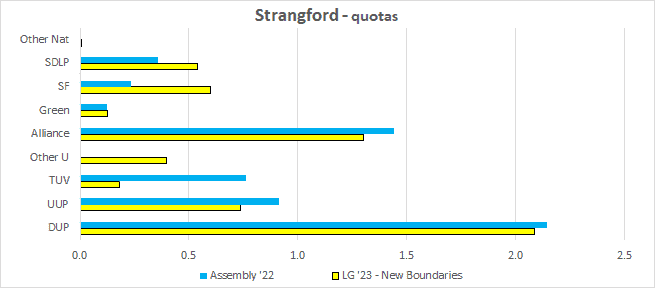
The Other Unionists are all Independents, with most of the votes coming from Newtownards. Since the UUP candidate there was elected on the first count and therefore could not receive transfers, we do not know how the Independent votes would have split between the DUP and UUP.
There are clearly still 2 safe DUP seats. The party may try running three candidates again, but even if it attracted most of the Independent votes, plus the majority of TUV transfers, it would be unlikely to have enough to keep all three candidates ahead of the UUP, even if they balanced perfectly. (Don’t forget that the UUP would receive some of the Independent votes and a portion of the TUV transfers as well). Perhaps more to the point, the DUP have no experience of balancing in Strangford. So, the UUP would also keep their seat.
Alliance would also be sure of one seat.
However, three DUP candidates could affect the outcome of the final seat by keeping potential unionist transfers tied up until very late in the count.
On these figures the SDLP are behind Sinn Féin, and that could substantially reduce the chances of nationalists winning a seat. That is because SDLP transfers more to Alliance than to Sinn Féin. The SF candidate would be unlikely to exceed about 0.8 of a quota on SDLP transfers.
That would set up a contest between Alliance and Sinn Féin for the final seat. At this point the second Alliance would be behind the SF candidate. It should be noted here that Alliance balancing was non-existent at the last election. (Indeed, it looks as if the party did not expect to be in the running for a second seat). It will need to balance well this time to ensure that its second candidate remains in the running long enough to have a chance of benefiting from transfers.
Unionist transfers might just be enough to carry the second Alliance ahead of Sinn Féin, but it would be touch and go.
If the SDLP outpolled Sinn Féin (which they did not do last month) then they would take the second Alliance seat on SF transfers.

The Resource Index shows how Alliance has built its presence in the constituency over the last year, gaining two more councillors this time. It will need to work those new resources hard to hold its second seat.

Even if the Conservatives and UUP both stand again, the DUP should still hit about 43 % to 44%. That is because it would gain the bulk of the TUV vote plus a substantial share of the Other Unionists. In 2019 it also received 3% points of the vote the UUP recorded in the earlier Council elections.
Alliance could be on 32% to 33% if it benefits from tactical voting to a similar extent as last time. It might even hit 35% to 36% given the larger pool of nationalists from which to gain tactical votes.
Upper Bann
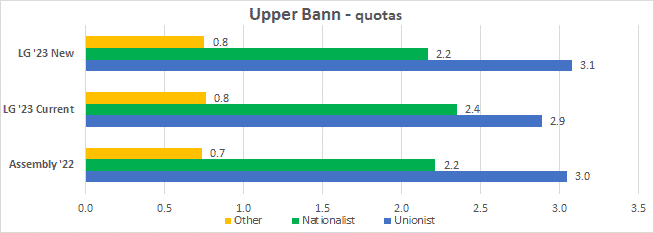
Comparing the results in the last Assembly election with the council votes cast within the current constituency boundaries shows that unionists lost ground. But it appears that the new proposed boundaries could actually put them in a slightly better position despite this.
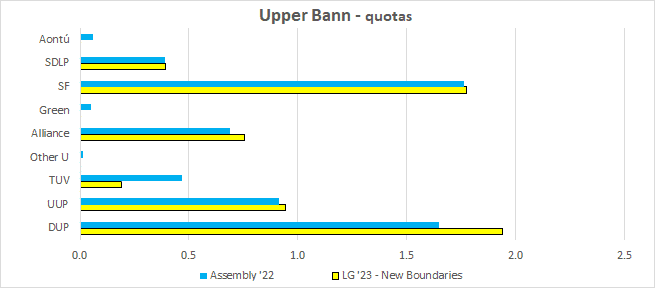
On these council votes the TUV would have been quickly eliminated in an Assembly election, putting 2 DUP and 1 UUP over the line. This would leave a small surplus to be transferred. Some of that surplus would come to Alliance, but at least a half would probably not transfer to anyone. The SDLP would be next to go, transferring about 5 votes to Alliance for every 4 to Sinn Féin. IF Sinn Fein were well balanced (and they have a good record in this constituency) both candidates and Alliance could be very close to each other. One SF MLA would be a certainty, but a handful of votes could turn the result of the last seat either to Alliance or Sinn Féin.
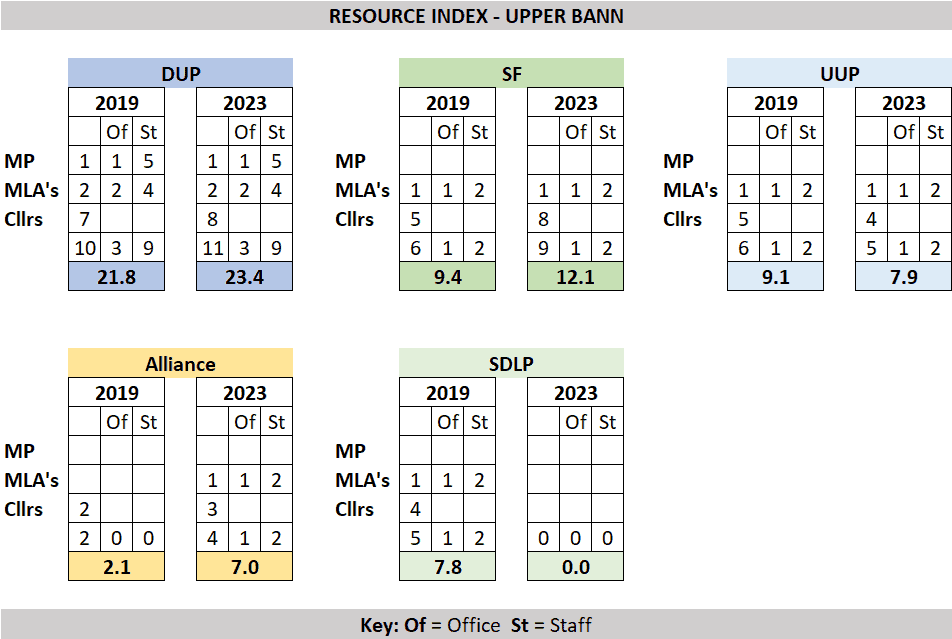
The Resource Index shows how both Sinn Féin and Alliance have put down deeper roots in the constituency over the last year to the total exclusion of the SDLP.

At the last Westminster election the DUP took 10% more of the vote than at the council elections earlier in the year. That is because the TUV did not stand and the UUP lost 5% points who tactically voted for the DUP. (The additional 2% came from Independent unionists.) This suggest that tactical voting could bring the DUP total up to the 40% mark.
Although a Sinn Féin victory remains highly unlikely – even if Sinn Féin achieved a stronger squeeze on SDLP voters, while the DUP were a bit less successful with UUP voters – that 30% figure for Sinn Féin will still concern to the DUP if the UUP are in the race again. Pressure on the UUP to stand aside can be expected. But we come to the same point again, if the UUP stand aside in a constituency where they hold an Assembly seat, will that not undermine their future prospects?
West Tyrone
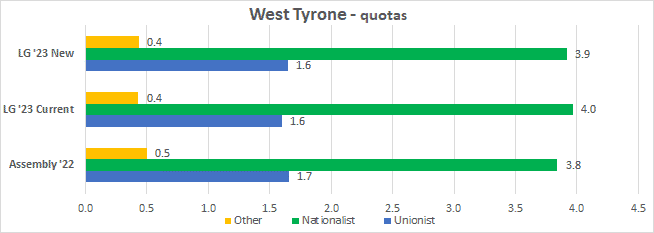
This is the eighteenth and last constituency, and I’m running out of ways to say, “Comparison of the last Assembly election with the recent council elections shows a swing to nationalists”. This time at the expense of both unionists and others. The new proposed constituency boundaries may dampen this slightly.
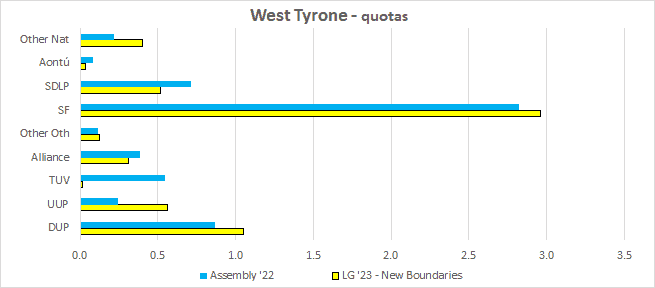
The Other Nationalist at the Assembly election was the Independent Paul Gallagher, who has been associated with dissident republicans. He is also one of the Independents who made up the Other Nationalists in the council elections. Unfortunately, no transfer information is available to show how his votes would split between SDLP, Sinn Féin or elsewhere.
The collapse of the TUV vote looks astonishing. What is more astonishing is the reason. There are seven District Electoral Areas which would be (in whole or in part) within the new proposed constituency boundaries. The TUV only stood a candidate in Cookstown – only a sliver of which will be within the constituency. The party abandoned a constituency where they had just over half a quota the year before.
An Assembly election on the same voting pattern as in the council elections would result in 3 Sinn Féin, 1 DUP and 1 SDLP as last year. That is because the SDLP would receive a proportion of the Other Nationalist vote and the majority of any Sinn Féin transfers, putting it and the UUP more or less on par, and ahead of Alliance. In a predominantly nationalist constituency the majority of Alliance transfers can be expected to favour the SDLP, giving them the final seat.
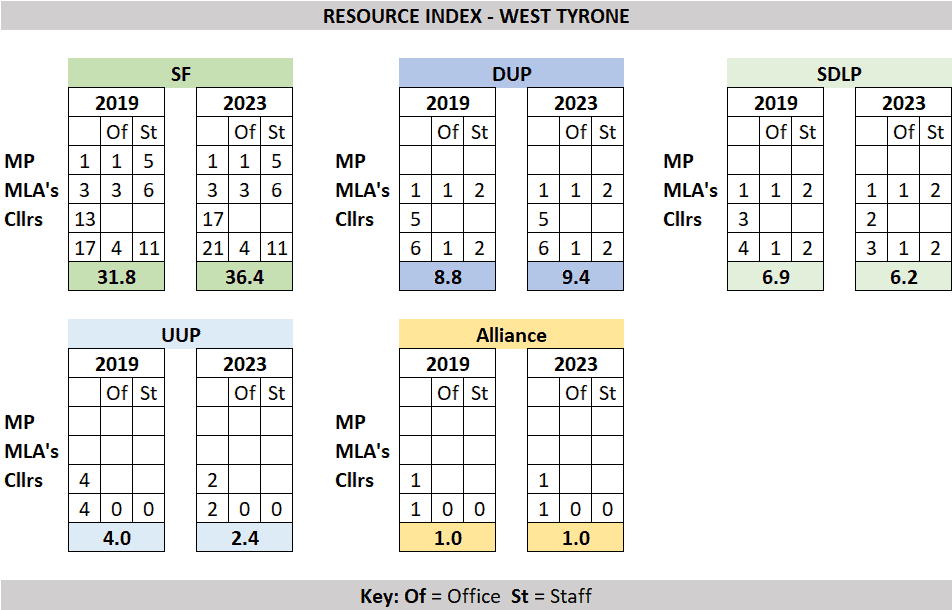
Sinn Féin has increased its predominance of the political resources of this constituency.
And when we compare the council votes to the last Westminster election it is obvious that there will be no change when that is held. Sinn Féin again.

SUMMARY
WESTMINSTER
If the council votes had been cast in a Westminster election under the new proposed boundaries, and the historic pattern of tactical voting had been followed: there would have been the possibility of changes in the following constituencies.
East Belfast: Improved Alliance prospects. Advantage probably still with DUP, although a continuation of differential turnout could make things close.
North Belfast: Even if the SDLP stand, Sinn Féin would probably still win.
South Belfast and Mid Down: Who stands, and who stands down, has the potential to change the outcome. Tactical voting a major factor. DUP, Alliance, SDLP and Sinn Féin could each be contenders. SDLP has incumbent advantage but came a poor fourth in the council vote (Alliance came first, DUP second, and Sinn Féin third).
East Londonderry: DUP would have its majority substantially cut.
Fermanagh and South Tyrone: Sinn Féin’s wafer-thin majority would increase.
Lagan Valley: Big reduction in unionist share. Alliance gain from DUP highly unlikely, but no longer inconceivable.
Foyle: SDLP and Sinn Féin likely to be on level pegging. Too close to call.
North Down: If there were no unionist unity candidate the DUP would challenge to take the seat from Alliance. Advantage with Alliance. If there were a united unionist candidate, the outcome would be highly uncertain.
ASSEMBLY
If the council votes had been cast in an Assembly election under the new proposed boundaries, there would have been the possibility of changes in the following constituencies. Please remember this is NOT a prediction just an analysis of the council vote. Much may change in the next four years.
North Belfast: The current Alliance seat would be challenged by the SDLP. Alliance has a resource advantage.
West Belfast: The current PBPA seat would be challenged by both SDLP and DUP. DUP possibly better placed.
East Antrim: The current second Alliance seat would be challenged by the second UUP candidate. Slight advantage to Alliance.
East Londonderry: Current SDLP seat would be lost to either Sinn Féin or Alliance. Advantage Sinn Féin.
Fermanagh and South Tyrone: Current third Sinn Féin seat would be challenged by SDLP, or even an Independent Republican should one stand.
Foyle: Current DUP seat to be challenged by UUP. Too close to call.
Mid Ulster: Current SDLP seat would be challenged by UUP. Too close to call.
South Antrim: Current second DUP seat would be challenged by Sinn Féin. Any reversal of differential turnout would advantage DUP.
South Down: Current Alliance seat would be challenged by third Sinn Féin candidate. Too close to call.
Strangford: Current second Alliance seat would be challenged by Sinn Féin. Advantage Alliance.
Upper Bann: Current Alliance seat would be challenged by second Sinn Féin. Too close to call.
Full details on all constituencies can be found in previous articles.
Michael Hehir is a retired sales and marketing manager. He studied in Northern Ireland but now lives between England and Italy.
Discover more from Slugger O'Toole
Subscribe to get the latest posts to your email.
